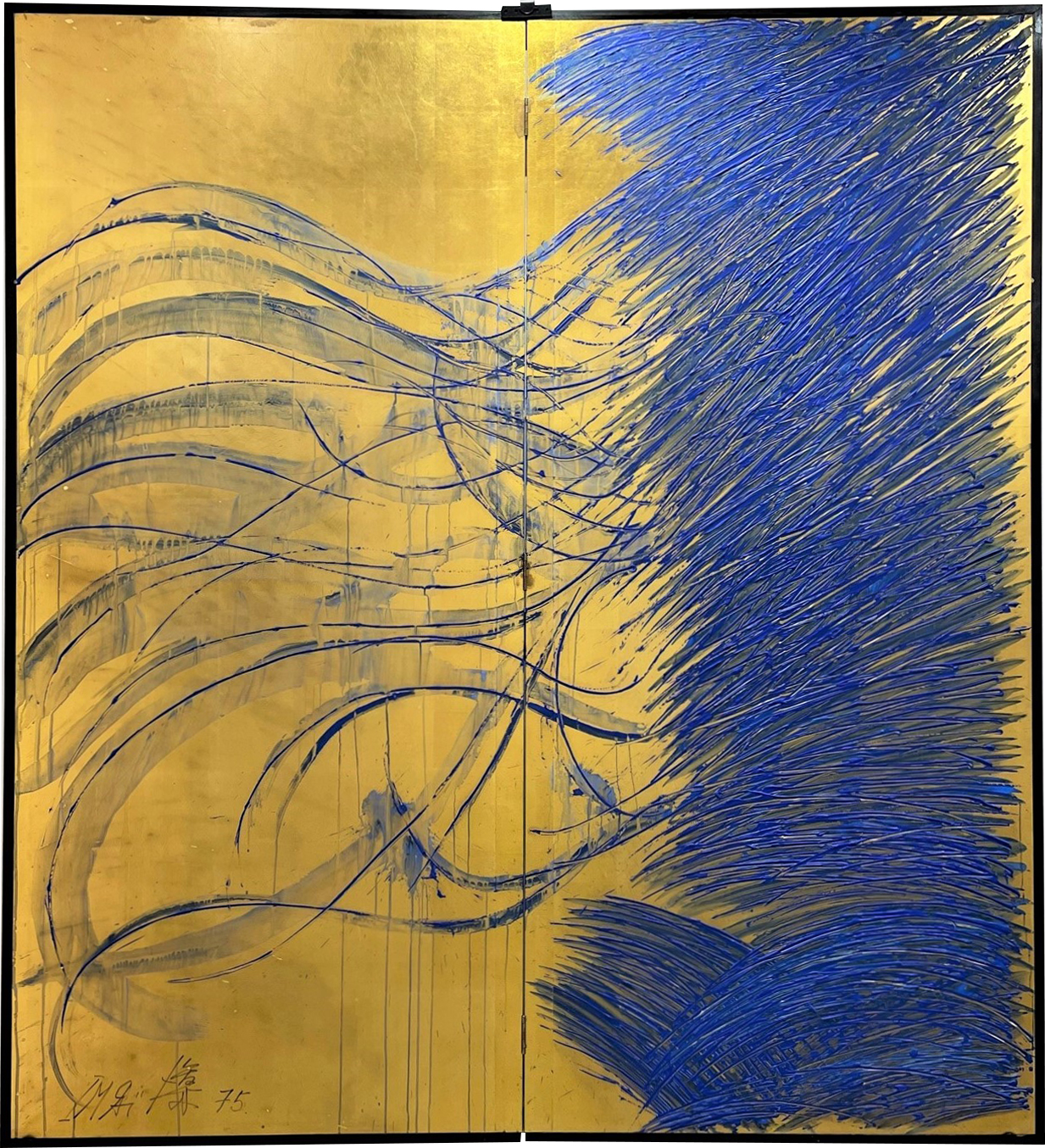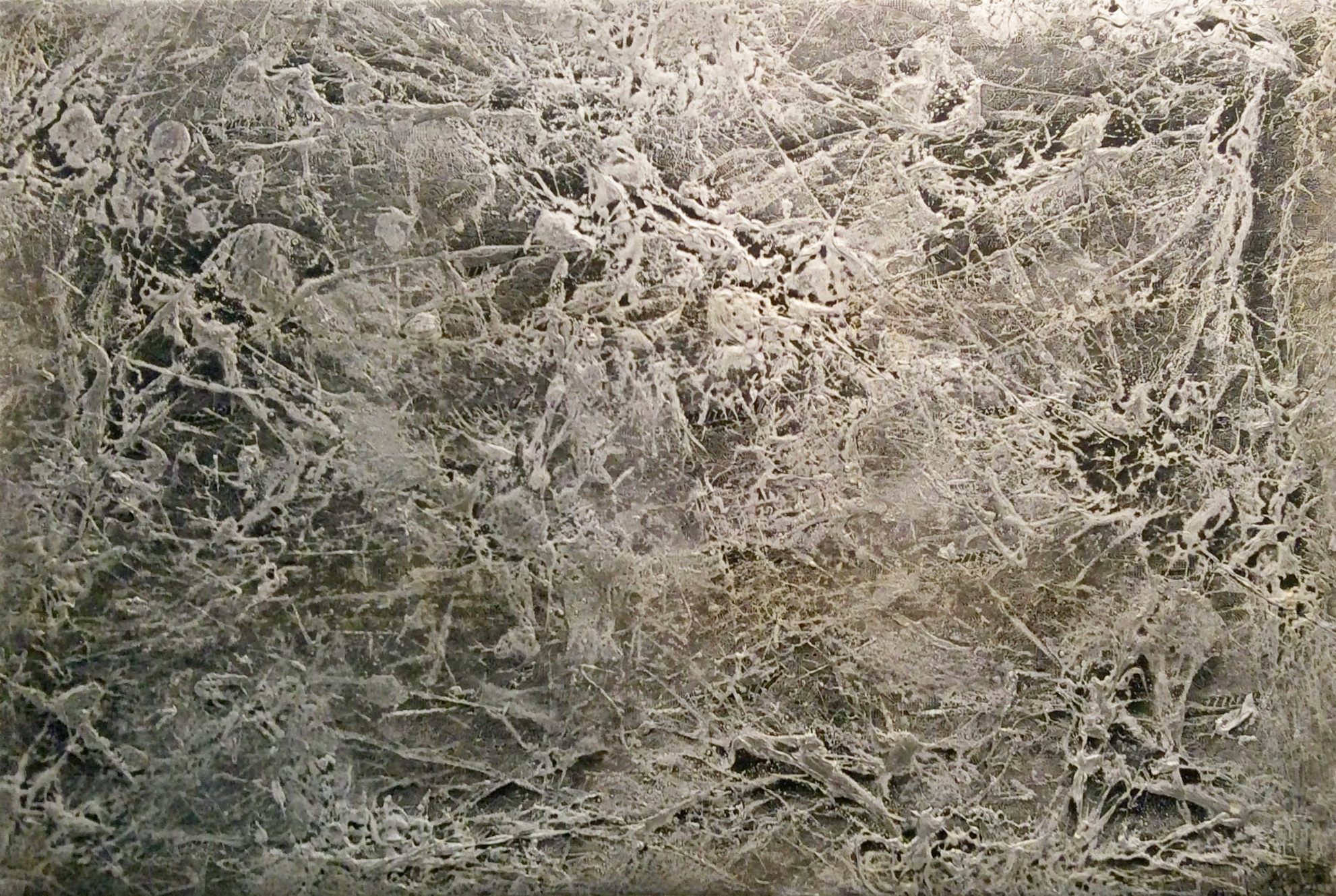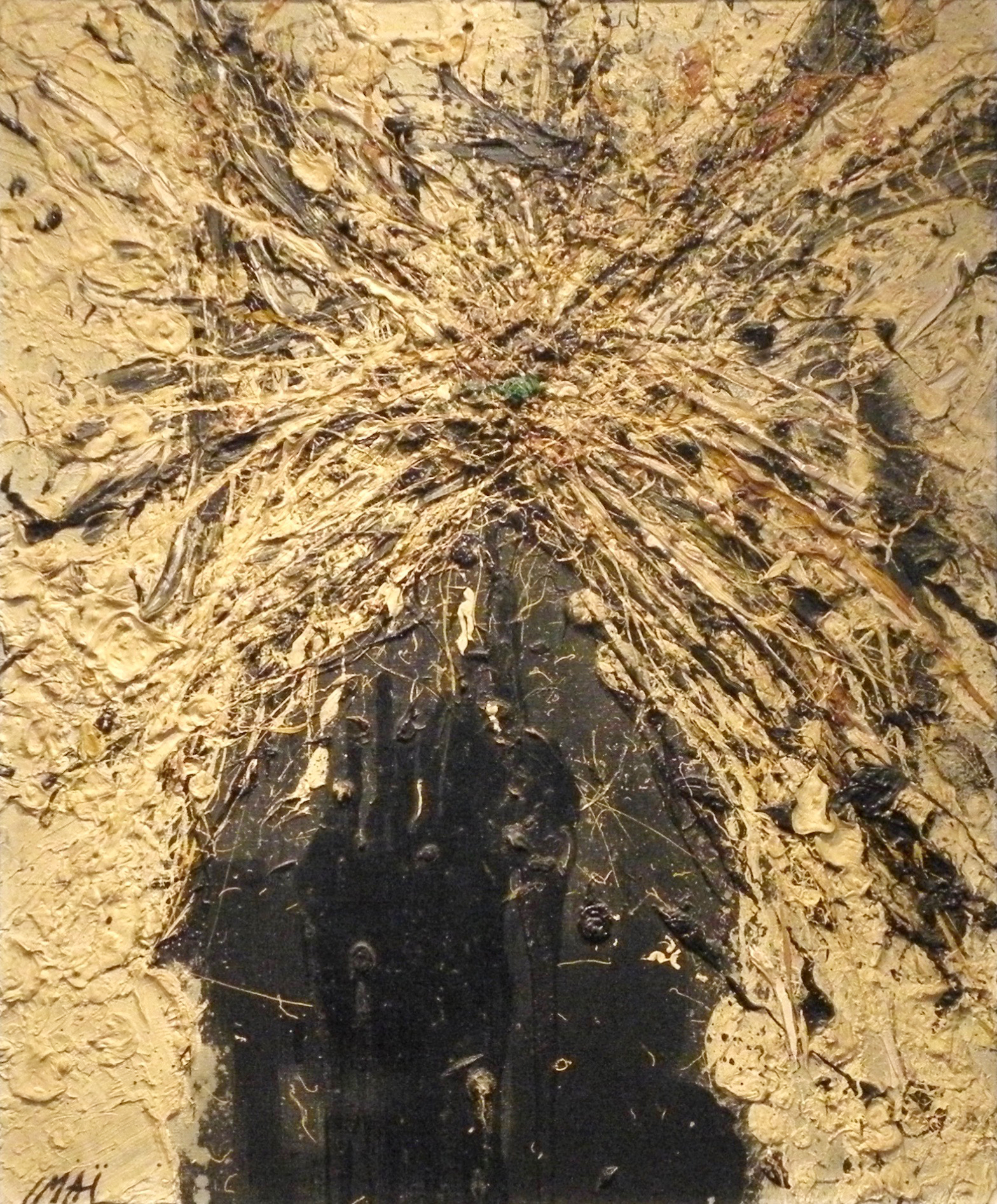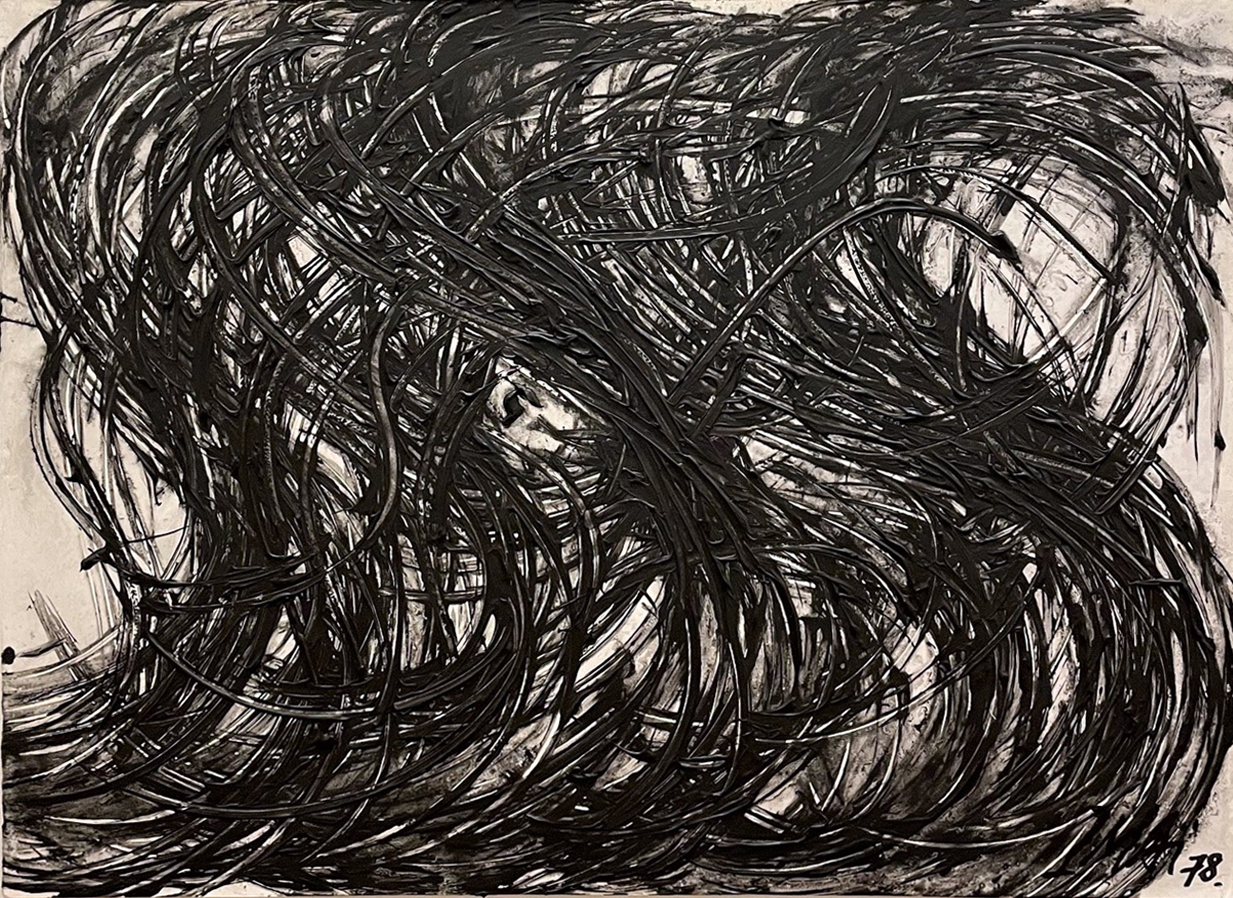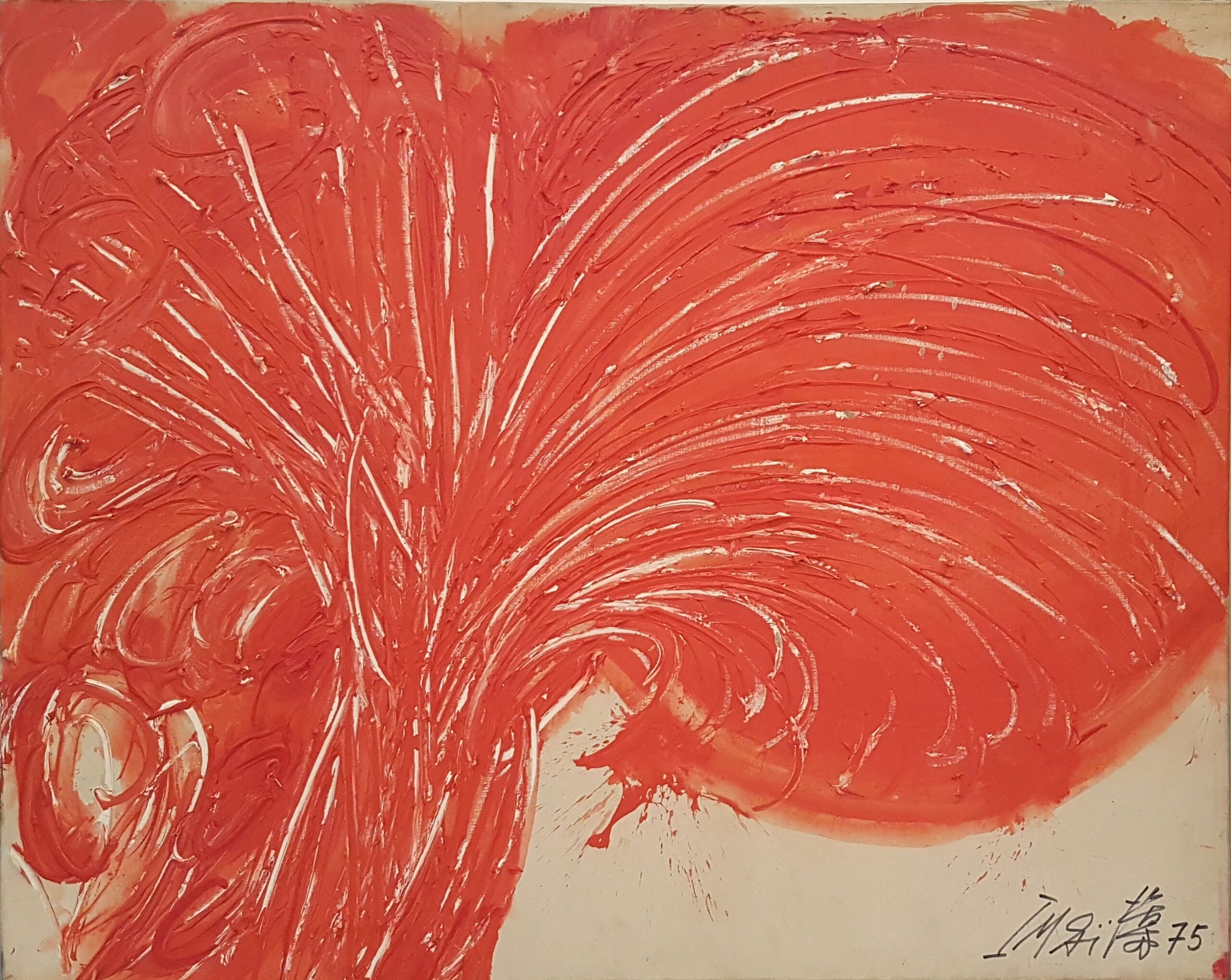Toshimitsu Imai
今井俊満
Toshimitsu Imai TOSHIMITSU IMAI
Born in Kyoto 1928-2002
A writer representing Abstract Expressionism in postwar art
He started oil painting in Musashi High School, and studied as an outbound student at Tokyo University of the Arts in 1950.
In 1952, he studied abroad in France at his own expense and studied at the Faculty of Literature, Sorbonne University. While studying abroad, he met Sam Francis and Sam Francis introduced then the critic Michelle Tapie to Imai. From around this time, he also participated in the Informal (amorphous abstraction) movement from his friendship with Georges Mathieu, Jean Dubuffet, Jean Fautrier, Cesar, Paul Jenkins, Henri Michaux, etc., and worked as a major member. He established an avant-garde style which is full of dynamism with a profound matiere and a violent touch as it is. He mediated Informal works to "World Today's Art Exhibition" held at Takashimaya in Nihonbashi in 1956. It was the first full-fledged exhibition in Japan to introduce Informal works, and Tapie, Francis, Mathieu and others visited Japan. In 1957, he held a successful solo exhibition at the Stadler Gallery in Paris, and in the same year he returned to Japan with Tapie and other artists, creating a so-called "Informal Sensation" through public productions and solo exhibitions.
Since then, he has held many solo exhibitions in Europe and the United States, and has exhibited at international biennales such as the Venice Biennale, the Sao Paulo Biennale, and the Paris Youth Biennale. He returned to Japan in 1968. In the 1980s, he started the "Kacho Fugetsu" series, which revives the traditional beauty of Japan, and at the point of exhibiting "Kacho Fugetsu" and "Hika Ochiha" at the Sogetsu Museum of Art in Tokyo, he turned into a magnificent style full of Rinpa-like elegancy. Since the beginning of the 1990s, he has worked on the "Rough Waves" series, "Hiroshima series" and "Kogal series", which combine the Informal method with the traditional Japanese style.
In 2000, he was declared that he had a terminal cancer and had a few months to live, he held a [Goodbye Exhibition] in December of the same year.
What made Imai, an Informal writer, internationally famous was the oriental sensibility hidden in the art. The tones based on vermilion, indigo, and green are clearly non-Western, and Imai clearly captured the underlying Japanese traditional aesthetics and used them as a means of breaking through Western stereotypes. We could see Japan’s aesthetic sense that links nature and art, as well as Imai's upbringing inspired by his father, who loved traditional culture, calligraphy, dry landscape gardens, and ceramics.
Born in Kyoto 1928-2002
A writer representing Abstract Expressionism in postwar art
He started oil painting in Musashi High School, and studied as an outbound student at Tokyo University of the Arts in 1950.
In 1952, he studied abroad in France at his own expense and studied at the Faculty of Literature, Sorbonne University. While studying abroad, he met Sam Francis and Sam Francis introduced then the critic Michelle Tapie to Imai. From around this time, he also participated in the Informal (amorphous abstraction) movement from his friendship with Georges Mathieu, Jean Dubuffet, Jean Fautrier, Cesar, Paul Jenkins, Henri Michaux, etc., and worked as a major member. He established an avant-garde style which is full of dynamism with a profound matiere and a violent touch as it is. He mediated Informal works to "World Today's Art Exhibition" held at Takashimaya in Nihonbashi in 1956. It was the first full-fledged exhibition in Japan to introduce Informal works, and Tapie, Francis, Mathieu and others visited Japan. In 1957, he held a successful solo exhibition at the Stadler Gallery in Paris, and in the same year he returned to Japan with Tapie and other artists, creating a so-called "Informal Sensation" through public productions and solo exhibitions.
Since then, he has held many solo exhibitions in Europe and the United States, and has exhibited at international biennales such as the Venice Biennale, the Sao Paulo Biennale, and the Paris Youth Biennale. He returned to Japan in 1968. In the 1980s, he started the "Kacho Fugetsu" series, which revives the traditional beauty of Japan, and at the point of exhibiting "Kacho Fugetsu" and "Hika Ochiha" at the Sogetsu Museum of Art in Tokyo, he turned into a magnificent style full of Rinpa-like elegancy. Since the beginning of the 1990s, he has worked on the "Rough Waves" series, "Hiroshima series" and "Kogal series", which combine the Informal method with the traditional Japanese style.
In 2000, he was declared that he had a terminal cancer and had a few months to live, he held a [Goodbye Exhibition] in December of the same year.
What made Imai, an Informal writer, internationally famous was the oriental sensibility hidden in the art. The tones based on vermilion, indigo, and green are clearly non-Western, and Imai clearly captured the underlying Japanese traditional aesthetics and used them as a means of breaking through Western stereotypes. We could see Japan’s aesthetic sense that links nature and art, as well as Imai's upbringing inspired by his father, who loved traditional culture, calligraphy, dry landscape gardens, and ceramics.
今井俊満 1928-2002
戦後美術における抽象表現主義を代表する作家
武蔵高時代に油絵を始め、1950年に東京芸術大学で1年間派遣学生として学ぶ。
1952年にはフランスに私費留学しソルボンヌ大学文学部に学ぶ。留学中、サム・フランシスを知り、その紹介で評論家ミッシェル・タピエを知る。この頃から、ジョルジュ・マチュー、ジャン・デュビュッフェ、ジャン・フォートリエ、セザール、ポール・ジェンキンス、アンリ・ミショー等との交友から自らもアンフォルメル(不定形抽象)運動に参加、主要メンバーとして活躍した。重厚なマチエールと、身振りそのままの激しいタッチによる躍動感あふれる前衛的スタイルを確立。1956年に日本橋・高島屋で開催された「世界・今日の美術展」の際にアンフォルメル作品の出品を斡旋、日本で初めて本格的にアンフォルメルを紹介した展覧会であり、タピエ、フランシス、マチューらが日本を訪れた。1957年パリのスタドラ―画廊で個展を開き成功を収め、同年には再びタピエ、作家らを伴って帰国し、公開制作や個展などを通じて、いわゆる「アンフォルメル旋風」を巻き起こした。
その後も欧米で多くの個展を開催、また、ベネチアビエンナーレやサンパウロビエンナーレ、パリ青年ビエンナーレなどの国際ビエンナーレに出品。1968年に帰国。
1980年代から日本の伝統美を蘇生させる「花鳥風月」シリーズに着手、東京・草月美術館で発表した「花鳥風月」「飛花落葉」を機に琳派風の雅趣溢れる壮麗な作風に転じる。
1990年代に入ってからはアンフォルメルの手法と日本の伝統様式を融合した「波濤図」シリーズ、「ヒロシマ・シリーズ」「コギャル・シリーズ」などを手けた。
2000年医師から末期がんで余命数ヶ月と宣告され、同年12月に[サヨナラ展]を開催した。
アンフォルメル作家、今井を一躍国際的に有名にしたのは、その芸術の中に潜む東洋的感性にあった。朱や藍や緑を基本とした色調は、明らかに非西洋的であり、今井は根底に流れる日本の伝統的な美意識を明確に捉え、西洋的な固定観念を突き破る手段とした。そこには自然と芸術とを連動して捉える日本の美意識を落し込むとともに伝統文化や書画、枯山水の庭や陶芸を愛した父親の影響による、今井の生い立ちも現れている。
受賞歴
1957エックスアンプロバンス国際バレー祭大賞(舞台美術)、1962現代日本美術展優秀賞、1975アンクラジュマン・オ・プログレー等勲章、1979紺綬褒章、1983フランス芸術文化勲章オフィシェ章、1995レジオン・ド・ヌール勲章シュバリエ章、1997フランス芸術文化勲章コマンド―ル章、2008文部大臣表彰
戦後美術における抽象表現主義を代表する作家
武蔵高時代に油絵を始め、1950年に東京芸術大学で1年間派遣学生として学ぶ。
1952年にはフランスに私費留学しソルボンヌ大学文学部に学ぶ。留学中、サム・フランシスを知り、その紹介で評論家ミッシェル・タピエを知る。この頃から、ジョルジュ・マチュー、ジャン・デュビュッフェ、ジャン・フォートリエ、セザール、ポール・ジェンキンス、アンリ・ミショー等との交友から自らもアンフォルメル(不定形抽象)運動に参加、主要メンバーとして活躍した。重厚なマチエールと、身振りそのままの激しいタッチによる躍動感あふれる前衛的スタイルを確立。1956年に日本橋・高島屋で開催された「世界・今日の美術展」の際にアンフォルメル作品の出品を斡旋、日本で初めて本格的にアンフォルメルを紹介した展覧会であり、タピエ、フランシス、マチューらが日本を訪れた。1957年パリのスタドラ―画廊で個展を開き成功を収め、同年には再びタピエ、作家らを伴って帰国し、公開制作や個展などを通じて、いわゆる「アンフォルメル旋風」を巻き起こした。
その後も欧米で多くの個展を開催、また、ベネチアビエンナーレやサンパウロビエンナーレ、パリ青年ビエンナーレなどの国際ビエンナーレに出品。1968年に帰国。
1980年代から日本の伝統美を蘇生させる「花鳥風月」シリーズに着手、東京・草月美術館で発表した「花鳥風月」「飛花落葉」を機に琳派風の雅趣溢れる壮麗な作風に転じる。
1990年代に入ってからはアンフォルメルの手法と日本の伝統様式を融合した「波濤図」シリーズ、「ヒロシマ・シリーズ」「コギャル・シリーズ」などを手けた。
2000年医師から末期がんで余命数ヶ月と宣告され、同年12月に[サヨナラ展]を開催した。
アンフォルメル作家、今井を一躍国際的に有名にしたのは、その芸術の中に潜む東洋的感性にあった。朱や藍や緑を基本とした色調は、明らかに非西洋的であり、今井は根底に流れる日本の伝統的な美意識を明確に捉え、西洋的な固定観念を突き破る手段とした。そこには自然と芸術とを連動して捉える日本の美意識を落し込むとともに伝統文化や書画、枯山水の庭や陶芸を愛した父親の影響による、今井の生い立ちも現れている。
受賞歴
1957エックスアンプロバンス国際バレー祭大賞(舞台美術)、1962現代日本美術展優秀賞、1975アンクラジュマン・オ・プログレー等勲章、1979紺綬褒章、1983フランス芸術文化勲章オフィシェ章、1995レジオン・ド・ヌール勲章シュバリエ章、1997フランス芸術文化勲章コマンド―ル章、2008文部大臣表彰
Biography


